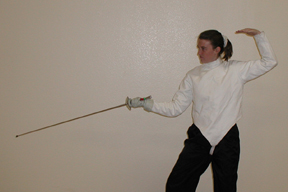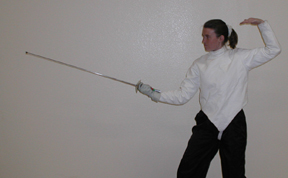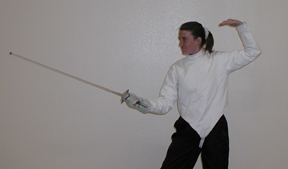Lessons 3 & 4
This lesson covers the direct attack and the various guard positions
(invitations).
The Invitation
The invitation is a starting (guard) position that invites your
opponent to attack in specifuc lines. As discuseed in class these
lines are high outside, high inside, low outside and low inside.
Each of the invitations will close one of these lines of attack.
For example, our starting (standard) on-guard position is an invitation
in third (terza) which closes off the high outside line of attack
making a direct attack to the high outside imptobable.
The folloing are pictures showing the invitations with
descriptions. As a note, reading material for this an subsequent
lessons may be found in William Gaugler's Science of Fencing or Luigi
Barbasetti's Art of the Foil.
Prima
 Prima
(first) is used to close off the low inside line. Please note
that the hand is at shoulder height. The picture to the right shows
first from the side. Note - for the guard pictures if you click on the
images to the left you will see a view from the front. All of the
invitations at this point will be made with the hand in supination
(palm up). In the Italian system the hand will be in fourth or
third-in-fourth, For prima I would suggest the hand being in
third-in-fourth.
Prima
(first) is used to close off the low inside line. Please note
that the hand is at shoulder height. The picture to the right shows
first from the side. Note - for the guard pictures if you click on the
images to the left you will see a view from the front. All of the
invitations at this point will be made with the hand in supination
(palm up). In the Italian system the hand will be in fourth or
third-in-fourth, For prima I would suggest the hand being in
third-in-fourth.
Seconda
 Seconda
(second) is used to close the low outside line. The hand should
be in fourth.
Seconda
(second) is used to close the low outside line. The hand should
be in fourth.
Terza
 Terza
(third) closes the high outside line. The hand may be in fourth
or third-in-fourth. This is the standard starting guard for the
class.
Terza
(third) closes the high outside line. The hand may be in fourth
or third-in-fourth. This is the standard starting guard for the
class.
Quarta
 Quarta
(fourth) closes the high inside line. The hand should be in
third-in-fourth.
Quarta
(fourth) closes the high inside line. The hand should be in
third-in-fourth.
The Parry
The invitations will also be similar to the parry positions. A
parry may be defined as follows:
A parry is a defensive move that
deflects an incoming attack.
The parry is a controlled technique used for defense that may or may
not be combined with footwork (to be discussed later). Barbasetti
said this of the parry: "Any movement
that renders an opponent's attack harmless is called a parry. In
the fullest sense, the stepping back, the dodging aside, the bending or
turning of the body away from your adversary's point could also be
termed a parry. In the present case, however, we shall discuss only the
parry proper - that is, such blade movements as serve the first purpose."
(p. 40) In the class only those defenses effected with the blade
will be called parries. To watch a video clip of a parry in
quarta click here. In class you
will learn to parry not only in quarta but also in prima, seconda and
terza.
The Riposte
The riposte is an attack made after a parry. In the French school
the riposte is a definite second action while in the Italian school the
parry and riposte are blended together making it harder to parry the
riposte. Click here to view a
video clip of a parry riposte.
Conclusion
Now you have techniques that will allow you to attack your opponent and
defend when they attack you. This is just the proverbial tip of
the iceberg. However, you must learn these first techniques to be
able to master more advanced techniques. Practice is the
key. The more often you are able to practice the drills given in
class the better you will become. The next set of lessons will
introduce you to footwork. Foot work will be used to place
yourself in an advantageous position so that you may attack.
 Prima
(first) is used to close off the low inside line. Please note
that the hand is at shoulder height. The picture to the right shows
first from the side. Note - for the guard pictures if you click on the
images to the left you will see a view from the front. All of the
invitations at this point will be made with the hand in supination
(palm up). In the Italian system the hand will be in fourth or
third-in-fourth, For prima I would suggest the hand being in
third-in-fourth.
Prima
(first) is used to close off the low inside line. Please note
that the hand is at shoulder height. The picture to the right shows
first from the side. Note - for the guard pictures if you click on the
images to the left you will see a view from the front. All of the
invitations at this point will be made with the hand in supination
(palm up). In the Italian system the hand will be in fourth or
third-in-fourth, For prima I would suggest the hand being in
third-in-fourth. Seconda
(second) is used to close the low outside line. The hand should
be in fourth.
Seconda
(second) is used to close the low outside line. The hand should
be in fourth. Terza
(third) closes the high outside line. The hand may be in fourth
or third-in-fourth. This is the standard starting guard for the
class.
Terza
(third) closes the high outside line. The hand may be in fourth
or third-in-fourth. This is the standard starting guard for the
class. Quarta
(fourth) closes the high inside line. The hand should be in
third-in-fourth.
Quarta
(fourth) closes the high inside line. The hand should be in
third-in-fourth.